On Jan. 23, 2011 — nearly seven years, some 2,500 days ago — my first column for HearNebraska.org published, announcing the launch of this very site. It detailed the all-night marathon a handful of us, including HN co-founder Angie Norman, undertook to ensure this project — whose genesis dates to 2009 as my master’s project at Michigan State University — saw the light of day. It’s surreal, for me, to reflect on that time. From the column:
“We’re too tired for shots, over at HearNebraska.org headquarters — just two icy blocks from the state’s Capitol Building. But when the site went live early this morning, we managed to add about a half-dozen, half-drunk glasses of wine to the growing collection of spent bottles, jars, coffee mugs and other caffeine receptacles that fueled the six of us who encircle them as if it’s a religious experience. But we’ve been working directly (and in spirit) with our diligent, talented programmer in Lansing, Mich., and collaborators across Nebraska — all with laptops casting hours and hours of enlightened glows on our faces while we got this site running.
“We’re not celebrating just yet, though. (That happens here and here.) There’s a lot of work to do before then — and we’ll be tweaking style and adding new functions in the days and weeks to come. Stick with us as we work hard to shape the site to fit your needs — whether you’re a classical pianist in Gering, a death metal guitarist in Waverly or a punk in Omaha. Tell us what you like, and what’s not working. …
“We’re covering Nebraska music as one scene. Join us.”
The thing was, there was no model for what we were creating. Our influences were limited to basically Punknews.org, SLAM Omaha and, significantly, Great Lakes Echo. But honestly, we didn’t have much of a plan for where it would go. We just kept our heads down, and worked as hard as we could to focus on that original mission, to “cultivate Nebraska’s vibrant, fertile music and arts community by providing resources and a voice for bands, artists and members of Nebraska’s creative class and the people and businesses that support them.” That meant doing our best to build relationships with people in as many sub-scenes as possible, to find people knowledgeable enough to write about these different worlds within Nebraska music, to find photographers willing to go to venues and document this cultural history.
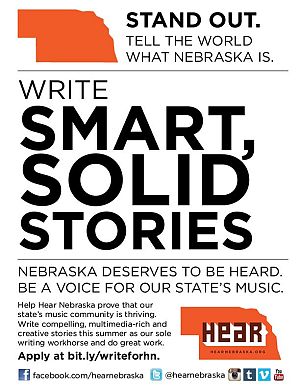
An early flyer we printed and distributed around the state in an effort to secure contributors
As the first entity to actively attempt to document all of Nebraska’s music scene, we were treading new ground. And it was a ton of fun. Before HN, a local band releasing a record would have to be lucky to score acknowledgement in the very limited space in one of the state’s daily newspapers. Otherwise, beyond promoting the album themselves through social media, their album releases often fell silently, like a tree in a forest. Through its news column, features, HN Radio player, HNFM radio show on KZUM, and other outlets, HN changed that for a ton of bands. For the first time, there was a publication focused solely on work Nebraska musicians were putting out, and on helping them maximize that effort through different kinds of journalism coverage. Over the years, we’ve produced a total of: 867 news columns; 3,512 feature stories; 14,787 calendar events; 30,032 Flickr photos and 315 YouTube videos. That we did all that with, at most, 1.5 full-time editorial employees, and a handful of interns, will never cease to amaze me. Did we miss shows? Of course. Did we have blind spots? Oh yeah. Did we offer a platform for people in the scene who felt ignored to rectify those issues by grabbing a camera or a keyboard and doing it themselves? I’m confident we did.
We had no financial model to make this thing work. Our initial plan for funding it — selling ads — quickly dissolved when I realized that I wasn’t ready (at least not yet) to switch from reporter to salesman. We didn’t know even a single big donor who could cut a check to help keep the lights on. But to be honest, we didn’t care. The work was addictive. We were breaking new ground, and we were putting everything we had into allowing HN to ride the momentum it was building through its readership.
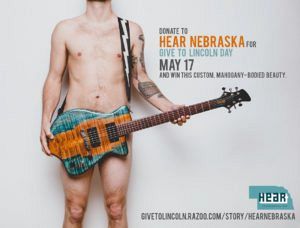
In lieu of any semblance of strategic fundraising early on, we just put it out there
Toward the end of that first year of operation in 2011, Angie and I realized this HN thing might actually be something that would stick, and we started teaching ourselves how to run it as an actual nonprofit. Through advice from people like FilmStreams founder Rachel Jacobson and the founders of Maha Music Festival, we slowly began shifting our focus from solely on the product we were putting out, to the process. How would we ensure this idea, which was quickly becoming an actual organization, could make it through year two?
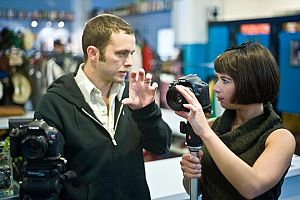
HN co-founders Andy and Angie Norman during a Love Drunk video shoot in 2011
Around that time, in 2012, we began producing events like the Hear Lincoln concert series, and forging partnerships with organizations and foundations who believed in the mission. We began paying bands to perform, and eventually, finding opportunities to pay journalists. As our programming expanded from strictly journalism to events (ultimately including the Good Living Tour, Lincoln Calling Music Festival, Hear Omaha, Hear Grand Island, An Evening concerts, Take Cover, Live at Turner Park, First Thursdays, Live at the 1200 Club, and many others) the organization really began to grow.
HN began attracting brilliant professionals who came to form, for my money, the state’s most dedicated, talented, dynamic board of directors (including Stephen Pedersen, Aaron Shaddy, Kendra Ingram, Jess Paisley, Tim McMahan, Marjorie Maas, Kristine Hull, Craig Meier, Nic Sweircek, Scott Hatfield). Meeting at 8 a.m. on the first Saturday of every month for years (not exactly rock ‘n’ roll hours), these individuals have helped steer HN’s ship through so many different, tricky, uncharted waters. They’ve helped me grow as an executive director. They’ve done it because they believe that Nebraska has a more nuanced, compelling story to tell about its attractions for artistic and creative talent. And they’ve seen HN help evolve that narrative.
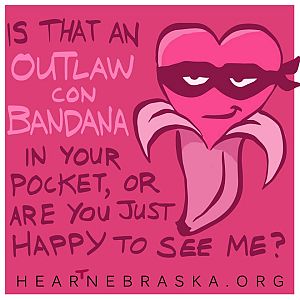
One of a couple dozen Nebraska music Valentines, illustrated by Neal Obermeyer
Since “patient zero,” Jordan Minnick, signed on before there even was an intern program in 2011, HN has attracted extremely talented young contributors. They often began as unpaid interns as they rose in the ranks to become one of our four managing editors (myself, Michael Todd, Chance Solem-Pfeifer and Andrew Stellmon), a program manager (Aaron Markley, Lauren Martin), a staff writer (Jacob Zlomke) or to earn a paid intern role (Jordan Hiebner, Lindsey Yoneda, Gabriella Parsons, Lauren Farris). We count more than 60 interns who have successfully “graduated” from HN’s intern program. And when I look at that list, I see a family. I’m so deeply proud of these people who shouldered the brunt of the work to craft HN into what it has become, through their passion, dedication, talent, and willingness to put themselves in challenging, often intimidating positions that forced them to grow.
I’m convinced that HN’s legacy is in these people.
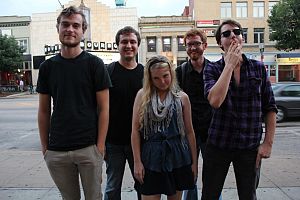
HN’s summer 2011 intern class (l-r): Matthew Masin, Bryce Wergin, Jordan Minnick, Michael Todd, Casey Welsch

HN’s 2016 Maha crew
Along the way, HN benefited from an incredible nonprofit education and resource infrastructure in Omaha and Lincoln. Organizations like Peter Kiewit Foundation, Omaha Community Foundation and Nonprofit Association of the Midlands offered training, insight, best practices, and human and other professional resources. Foundations such as Woods Charitable Fund, Cooper Foundation and Sherwood Foundation helped us grow our capacity to do ever more, ever better. An incredible number of small donors pitched in on Gives days to show their support, and to help make the engine turn.
It kept turning, and turning. We started this thing by keeping our heads down and only occasionally looking up. Every time we did look up, we’d be surprised at how far we’d come. As the organization grew in every way — budget, staff, administrative requirements (insurance, taxes, legal, etc.), programming output and impact — so too did our responsibility to operate it thoughtfully and effectively. We started setting our sights further down the road. Angie and I decided that we were only going to keep HN running as long as it was having an impact. If we started to stagnate, or if our impact began to wane at any point, we would reassess, strategize, and only then continue to push forward. We’ve done that countless times over the last seven years, creating new programs, shifting in new directions, killing or putting programs on hiatus as needed.

A flyer for an early program, the HN Hotline, where readers could tell us anything… and they did

Omaha’s Digital Leather appeared in illustrated monster form for our Jumbled Songs riddle game, one of a handful of kid’s activity pages contributor Neal Obermeyer created for HN
Over the last couple years, our team realized that to truly impact Nebraska’s music industry — to increase opportunities for musicians to make a living creating art, to build audience for our venues, to help bands get to their next, individually specific, level — we needed to do two things: focus on kids, to grow the future music scene and industry; and be more efficient in how we’re distributing our limited resources to professional artists (i.e., we need to focus on helping the musicians who are hustling to grow, through touring, recording and releasing music).
We also accepted the fact that HN had essentially maximized its capacity with its relatively narrow mission scope: original Nebraska music. To make the shift that mission effectiveness demanded, we needed to think outside the box. We needed to expand our reach and scope. That’s where The Bay comes in.
Founded by Mike Smith (a fellow Imperial, Neb.-native who has been a close friend of mine for 20 years), The Bay started in 2010 in similar fashion as HN: i.e., Mike wanted to create a place that didn’t exist, a place where he would have given anything as a kid to spend time, and he really had no idea how he was going to do it. Beginning as an indoor skatepark in a mall in Lincoln, The Bay quickly gained a reputation as a place to go for kids for whom traditional education and athletic clubs/programs didn’t suit, giving them something to do that grew their skills and confidence, and people who cared about them. After moving to a giant warehouse in 2012, The Bay really started to develop. Today, The Bay is a 30,000-square-foot building in Lincoln dedicated to creating opportunities for youth to connect with positive activities, role models and the community. Here’s what it does:
- It’s Nebraska’s largest indoor skatepark, featuring weekly skate school, and the All-Access pass, which allows free skating for more than 110 of Lincoln Public Schools’ low-income students.
- It’s one of Nebraska’s only booze-free, all-ages concert venues, which hosted more than 100 events in 2017, including Lincoln Calling, Queerfest and Do-It-Ourselves Fest.
- Its third-wave coffee shop is not just the best place in the city to get a great cup of joe, but its Community Cup program distributed 1,620 free cups of coffee to those who couldn’t afford them.
- In addition, it’s also a drop-in center where at-risk women and girls can get diapers, formula, and other necessities in a dignifying way. A food bank distribution spot that served 1,900+ meals in 2017, The Bay will host food banks three time each month in 2018.
- And so much more.
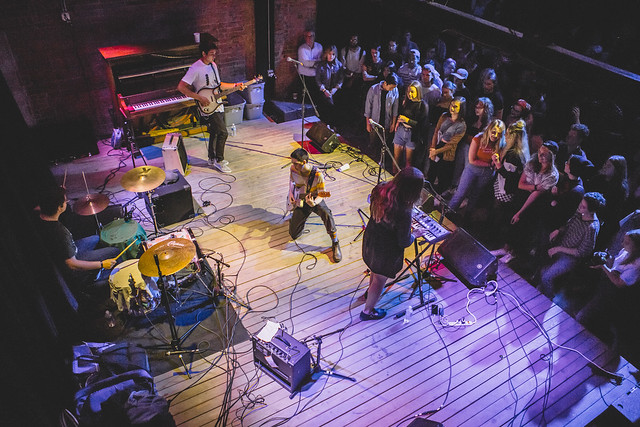
Frankie Cosmos at The Bay | photo by Lauren Farris
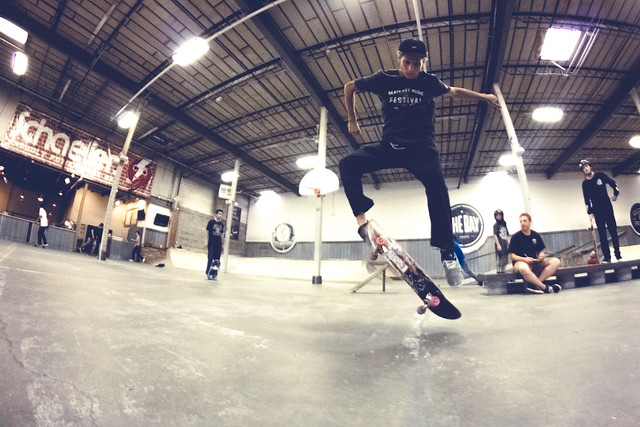
Lincoln Calling Skate Competition at The Bay | photo by Alex Ruybalid
Having partnered with The Bay dating back to Skate the State in 2011, and having seen firsthand the impact they’ve had on kids and families, I’m incredibly proud of what Mike and his bonkers-talented team have created. And, holy shit, there’s so much potential to do even more.
So let’s get to it: If you’re reading this column, you’re aware that Hear Nebraska and The Bay are merging. But you might still be wondering why, and what this means for HN as you know it.
The why comes down to HN leadership’s belief that you either evolve, or you die. We’d reached a point where our staff (3.25 FTE) and fundraising capacity was basically maxed. We couldn’t add new programs, which meant we couldn’t make that necessary shift toward youth programming and more focused professional development for working musicians.
By joining forces with The Bay as programs (along with Skate for Change) under Rabble Mill, we gain human and development resources that allow us to refocus the traditional “HN” programming in a way that more effectively grows and strengthens Nebraska’s music community and industry. Truly, it feels like a 1 + 1 = 3 equation. In addition to strengthening the meaningful work The Bay is already doing, as well as events like Skate Art Music Festival and the Good Living Tour, I’m incredibly excited for us to create new programs together, including:
- Job training/shadowing for youth (focused on those considered at-risk) in the areas of music, tech, journalism and coffee. For you music-focused readers, this means we’ll use The Bay venue as a training ground to develop the next generation of sound people (read: not just men), bookers, promoters, guitar techs, tour managers, performers, etc., etc. Pair that with our intent to turn kids into versatile, talented photographers, videographers and storytellers, and we’ll be creating a farm league that, over time, will send top-notch young professionals to intern and eventually work for or create Nebraska venues, promotion companies, labels, studios and other music-related businesses.
- A print magazine produced by kids aimed at exposing Nebraska high schoolers to the state’s most interesting, positive subcultures, including music-related features on bands, venues, record stores, and other nonprofits (similar to how we’ve done it all this time), but also on other creative/arts endeavors, including skateboarding, visual art, design, maybe even food!
- Professional development aimed to help musicians reach their next level. Maybe that’s career consultations, or education in booking/promoting a successful tour, or band management/organization/legal aid. Maybe it’s a killer press kit, or help finding a van to hop into in the first place. The fun component here is that these same musicians will be required to give back by teaching/mentoring young people.
- And the Find Your Grind Collective, a digital art and design space focused on closing our community’s technology gap through skills creation. This is the hub through which all the above programs will be created.
The mission of Rabble Mill is to create more skilled, supported, connected communities through education, outreach and storytelling across subcultures — skateboarding, music and art. We plan to use The Bay-Lincoln as a model for an eventual The Bay-Omaha, and beyond.
So that’s where HN is headed. I couldn’t be more excited. Of course, to make way for this new direction shift, we’re letting go of some things.
First, we’re handing off control of two programs that we put a tremendous amount of care and energy into, but which are now at the point where they can run without us: Lincoln Calling Music Festival, and the Hear Grand Island concert series.
Longtime HN contributor (and one of Lincoln’s predominately hardest-hustling music community members) Spencer Munson will take the reigns of Lincoln Calling in 2018. Spencer helped founder Jeremy Buckley run the festival for years before we took it over in 2016. And he was instrumental in our work to grow it from a small local festival to one that drew in 2017 more than 700 people from outside the city (including from 75 cities, 21 states, Algorta, Spain and Mexico City). With a solid system and structure in place, I have no doubt Spencer will continue to operate LC at an increasingly high level. We’ll help as needed along the way, and you should, too.
After attending our 2015 Good Living Tour stop in Grand Island, business owners Sharena Anson and Brent Lindner formed the impetus for the creation of Hear Grand Island in 2016. As a 10-week concert series, that event surpassed just about everyone’s expectations, drawing as many as 2,000 people on a given Friday night to the heart of the city’s reinvigorated downtown. With the help of passionate Nebraska music veteran TJ Roe, Brent and Sharena no longer need our help to run the series’ third season in 2018. We’re proud of them, and chalk up both of those hand-offs as big wins.
We just want cool shit to happen. We have no intention or need to own or run it all.
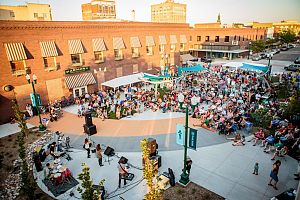
Field Club plays Hear Grand Island 2016 | photo by Lauren Farris
The biggest change our die-hard followers will see comes right here at HearNebraska.org. As of this column, we’re hitting pause (not stop) on our coverage of Nebraska music, including our events calendar, HN Radio, and editor Andrew Stellmon’s tri-weekly news column (as he detailed here). Having put enormous human resources into updating this site and its social channels every day since Jan. 23, 2011, we’re going to direct that energy toward creating some of the new programs I’ve mentioned, and strengthening others. That will include the print publication, whose broader editorial scope — skateboarding, music, art — likely will be reflected on these digital pages.
In the meantime, everything published on this website will continue to be accessible. For me, the historical component of what we’ve done with our journalism has always been the most important service Hear Nebraska provides. I’m pleased that, in the same way I still revert to the archived Star City Scene for background on Nebraska music from 2003-2007, music lovers will always be able to use HearNebraska.org for quantitative music coverage from Jan. 23, 2011-Dec. 31, 2017.
Don’t worry. Once we’re ready to step back into the storytelling saddle, we’ll still cover Nebraska music, through words, photos and video. But we won’t solely focus stories on Nebraska music. We’ll showcase skateboarding, digital art, and honestly, just about anything the new young storytellers we develop want to show you. We’ll still run our weekly, 2-hour radio show — HNFM — Mondays from 8-10 on 89.3 FM KZUM and kzum.org. And we’ll produce our fourth-annual Good Living Tour in 2018 (and we have some new tricks up our sleeves).
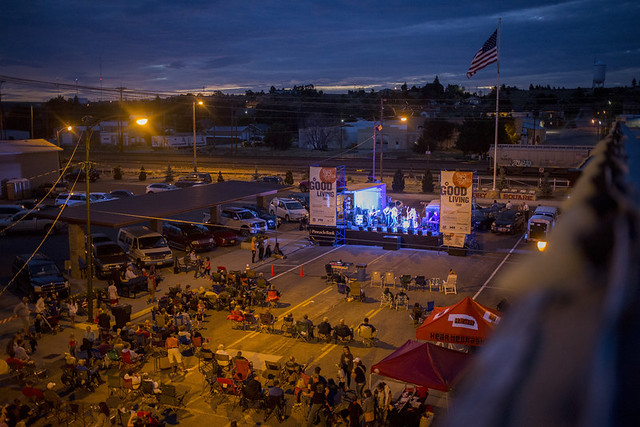
The Good Living Tour 2016 in Sidney | photo by Andrew Dickinson
The truth is, we surpassed our original expectations for Hear Nebraska many years ago. Early on, if you would have told Angie and I that HN would go on to produce three records (two on vinyl), and that we’d take some 140 of Nebraska’s top bands on three statewide tours, that would have eclipsed our dreams for this project. But ambitions grow. And thanks to you, the HN’s potential continues to expand in ways we never saw coming.
Whether you’re a regular reader, an occasional donor or a one-time contributing photographer, we appreciate your support more than you could possibly know. We’ve made so many friendships during these years, and have been fortunate to surround ourselves with some of the most creative individuals in the state. We’re grateful for all of you. Thank you for believing in us, for caring about Nebraska music, and for trusting us to continue fighting the good fight for Nebraska music and culture.
This is not the final chapter of Hear Nebraska. This is the start of a new one. We’re excited to turn the page, and can’t wait to show you what we have in store! Please stick with us, and be patient as we make this exciting transition.
Signing off (for now),
Andrew Norman





